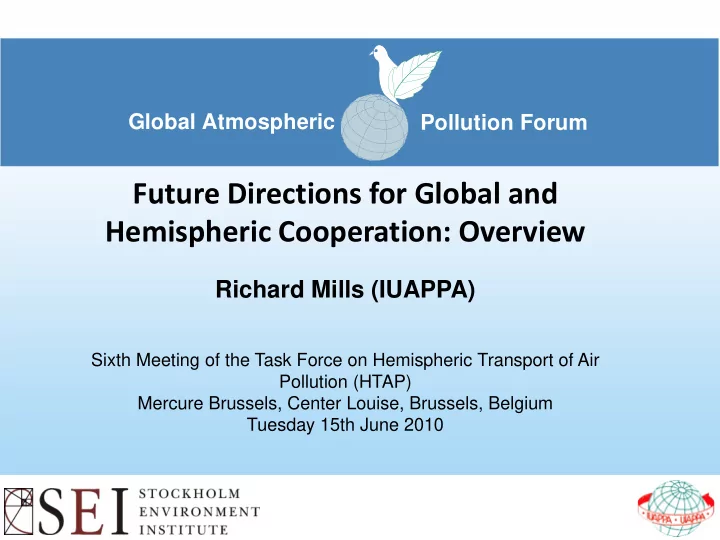

Global Atmospheric Pollution Forum Future Directions for Global and Hemispheric Cooperation: Overview Richard Mills (IUAPPA) Sixth Meeting of the Task Force on Hemispheric Transport of Air Pollution (HTAP) Mercure Brussels, Center Louise, Brussels, Belgium Tuesday 15th June 2010
Where are we now? • Legal agreements – Stockholm Convention, Montreal Protocol, CLRTAP + Protocols, UNFCCC/Kyoto Protocol, ASEAN Haze, etc ** • Regional cooperation agreements – Malé Declaration, EANET, APINA, other intergovernmental networks • Institutions with air pollution interests – UNEP, WMO, WHO, FAO, UNDP, regional commissions, etc. ** Related Conventions – Biological Diversity, Desertification, regional seas (e.g. OSPARCOM), etc.
Need for Enhanced Cooperation • More effective links with climate change • An integrated approach promoting cost effectiveness • ‘Global voice’ for air pollution vis-à-vis other environmental priorities and international conventions • Consensus framework for identifying key emerging issues • A stronger basis for developing legally binding international agreements
Drivers of progress • Technological innovation • Convergence of data systems and science • Intergovernmental policy agreements Key message : Need for progress on all fronts. First two essential but not enough…
Key constraints • Wider – often unrelated - political conflicts • Costs of action – and competition for economic advantage • Complexity and delays inherent in any international process • Inter-organisational rivalries and vested interests • ‘the inter-connectedness of things’ – where to draw the boundaries
Long-term ‘scenarios’: (i) ‘starting over’ • A new mechanism – attractively simple • but many problems - Could air pollution command enough political time and attention? - long and complex negotiations, no certain prospect of success - what to do about existing institutions? - might just increase the complexities
Long-term ‘scenarios’: (ii) ‘climate change option’ Pros: …. • a basis to build on: IPCC chapter and some financing mechanisms • May seem obvious route for tackling short-term forcers Cons: …. • How to relate to other non-GHG pollutants? • Requires change of political attitude
Long-term ‘scenarios’: (iii) ‘closer integration of existing systems’ The core would be closer linkages between UNECE and UNEP. This could provide basis for effective inter- regional coordination and cooperation But: … • Global Framework Agreement might still be required. • Revisit debate on opening up LRTAP Convention • Must link to climate change policy process: finalise Gothenburg Review as a model for future regional integration of air pollution and climate?
Possible pathways and first steps Impossible to anticipate which scenario most likely to emerge. So need to find intermediate steps which are positive for all potential long-term scenarios • Further strengthening of regional networks • Strengthen existing international air pollution systems e.g. marine and air transport • Coordination of international monitoring /assessment systems • Prepare ground for global air pollution ‘framework agreement’ • Climate - Air Pollution Co-benefits
What does this mean for LRTAP? and HTAP? • Review of Gothenburg needs to take account of climate co-benefits and short-term forcers. • Need more systematic links with UNEP and WMO and framework for consultation with UNFCCC and IPCC • Keep ‘opening the Convention’ on the table • Continue to strengthen links with other regional networks • New HTAP work program to explicitly embrace global as well as hemispheric links.
Thank You
Recommend
More recommend